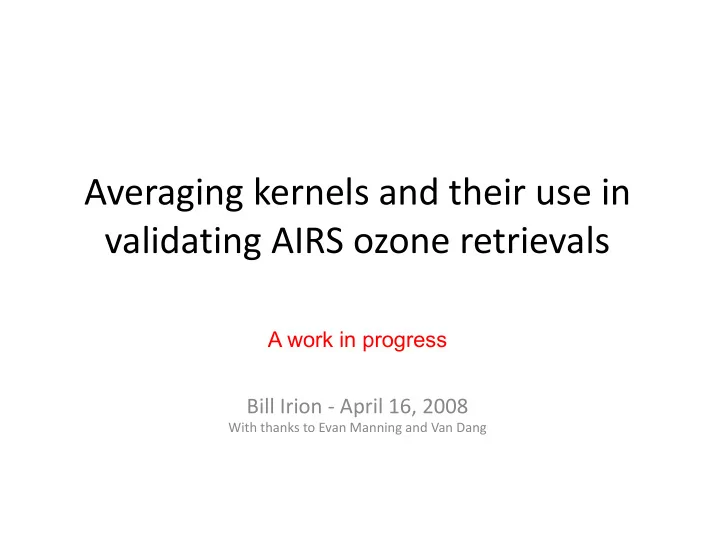

Averaging kernels and their use in validating AIRS ozone retrievals A work in progress Bill Irion ‐ April 16, 2008 With thanks to Evan Manning and Van Dang
What’s an averaging kernel? The averaging kernel matrix is a measure of how and where the retrieval is sensitive to changes in the “true” state. Retrieved state vector (e.g., an ozone profile) A = ∂ ˆ x ∂ x “True” state vector For AIRS averaging kernel derivation and discussion, see Maddy and Barnet, Vertical resolution estimates in Version 5 of AIRS operational retrievals, submitted to IEEE Trans. Geosci. Remote Sensing , 2007
For AIRS, averaging kernels are new for Version 5 retrievals Retrieval determined through perturbing trapezoids m − 1 + T Δ ˆ ˆ m = ˆ ( ) x x α Ozone trapezoids m 0 + T = ˆ ( ) ˆ x α Averaging kernel from AIRS L2 is on the trapezoid grid, not the retrieval grid. A = ∂ ˆ α ∂α So on the trapezoids:
Averaging kernel for ONE level Sensitivity for 0.1 ozone trapezoid San Cristobal Pressure (mb) centered at 86 mb Stars mark geometric centers of trapezoids Half-width at 1000 0.15 0 half-maximum a ∂ ˆ α / ∂α measure of vertical resolution
Sample averaging kernel for all trapezoids 0.1 Ozone - San Cristobal Pressure (mb) Geometric mean pressures of trapezoids 1000 0.0 0.6 ∂ ˆ α / ∂α The trace of the Averaging Kernel matrix is the degrees of freedom for the retrieval.
Verticality The sum along a row (or column) of an averaging kernel is a rough fraction of how much the result in a trapezoid comes from the spectral data (vs. the a priori .) San Cristobal Averaging Kernel Verticality 0.1 Pressure (mb) 1000 0.0 0.6 0.0 1.0 2.0 ∂ ˆ α / ∂α
Verticality The sum along a row (or column) of an averaging kernel is a rough fraction of how much the result in a trapezoid comes from the spectral data (vs. the a priori .) San Cristobal Averaging Kernel Verticality 0.1 Pressure (mb) 1000 0.0 0.6 0.0 1.0 2.0 ∂ ˆ α / ∂α Verticality >> 1 may indicate a problem in damping and trapezoid selection.
Averaging kernel can be placed on the 100-level AIRS support grid by calculating the psuedo-inverse trapezoid matrix: − 1 T T T T = T T T [ ] ′ 100 − level = T A trapezoid T T A ′ ′ 0.1 Pressure (mb) 1000 0.0 0.6 0.0 0.1 ∂ ˆ x / ∂ x ∂ ˆ α / ∂α x = ln(slab column)
Using Averaging Kernels with correlative “truth” data • Every retrieval uses a combination of observed data and an a priori x est = x 0 + A ( x T − x 0 ) ′ • If sensitivity were perfect, A = I ′ • If were replaced by “truth” (say, an ozonesonde x T profile), then would be a measure of what the x est instrument should have returned given its smoothing and sensitivity. • This assumes a linear regime.
San Cristobal Example comparisons of slab columns Churchill Slab Columns (molecules cm -2 )
Procedure • Ozone data from WOUDC (great stuff!) • Slab columns calculated for ozone on AIRS 100‐level grid • AIRS retrievals used to fill in “truth” above range of sondes • Sonde data must at least reach 10 mb • 3 hr, 50 km matchup range • “Kerning” calculation on sonde data uses ln(slab column) for ozone: ln x est = ln x 0 + A (ln x T − ln x 0 ) ′
WOUDC locations
Polar ozone
Polar ozone A priori missing ozone hole?
Tropical ozone
Tropical ozone Tropospheric a priori high Tropospheric a priori low
N. mid‐latitude ozone
Conclusions • Comparison of sondes convolved with averaging kernel with retrievals generally indicate agreement within ~20% in the extra‐tropics – but retrieval can often not recover from poor first guess. • Further work needed to understand high (>>1) verticalities – Change trapezoids and damping? • Ozone comparison indicates large departures from zonal means affecting retrieval – Final result sometimes worse than 1st guess – work on regional a prioris?
Recommend
More recommend